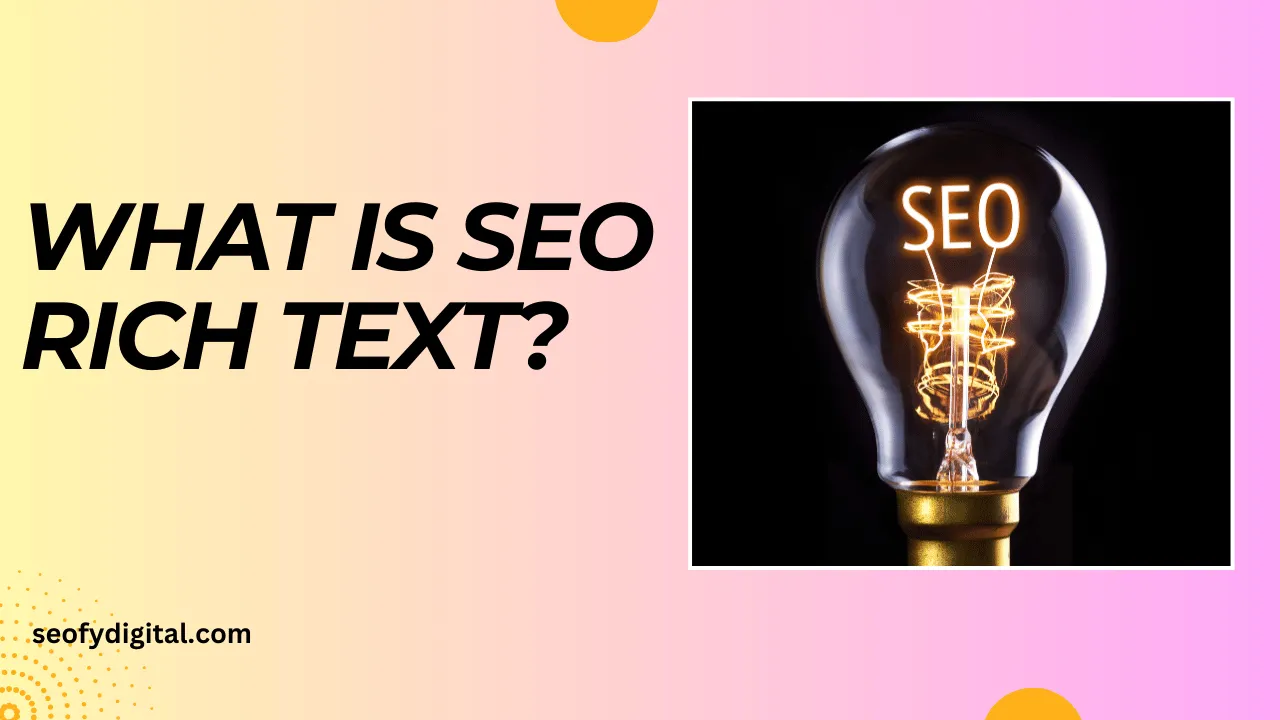Today, achieving top search engine rankings isn’t just about cramming keywords into content. Search engines like Google are increasingly sophisticated, using complex algorithms to evaluate content relevance, user experience, and readability.
In this evolving landscape, SEO Rich Text is one of the most powerful tools for making content accessible to both users and search engines alike. SEO Rich Text is about formatting and structuring content to make it easier to understand for both human readers and search engines.
By using specific techniques like semantic HTML tags, strategic keyword placement, and enhanced readability, you can create content that stands out in search results and offers a smoother, more engaging experience for readers.
In this article, we’ll delve into what SEO Rich Text entails, why it’s essential, and how you can leverage it to elevate your content. Whether you’re a content creator, website owner, or digital marketer, learning these principles will provide you with tangible, lasting benefits for both SEO and user engagement.

Contents
1. Understanding the Basics of SEO Rich Text
What is SEO Rich Text?
SEO Rich Text is a method of formatting and structuring content that goes beyond basic keyword optimization. By using elements like headings, bolded text, lists, links, and alt text, it makes your content more scannable, accessible, and understandable for search engines. Unlike plain text, SEO Rich Text includes HTML elements that add context and hierarchy to the content.
Why is SEO Rich Text Important?
SEO Rich Text has multiple advantages, primarily focusing on improving your site’s search engine rankings and enhancing the user experience. When content is structured and styled for clarity, it attracts more visitors, reduces bounce rates, and increases engagement.
Additionally, as search engines become more user-focused, SEO Rich Text helps ensure your content meets these new expectations, giving you an edge over competitors who rely solely on keywords.
Key Components of SEO Rich Text
- Headings (H1, H2, H3): These give structure to content, helping both users and search engines navigate the information. Search engines also prioritize keywords in headings, so strategically placed headings can boost your ranking.
- Bold and Italic Text: Emphasizing key terms by bolding or italicizing them can enhance readability and increase keyword relevance in search engines’ eyes.
- Links (Internal and External): Including relevant links can increase content authority and connectivity. Internal links help search engines understand the relationships between pages on your site, while external links to authoritative sources build credibility.
- Images with Alt Text: Adding alt text to images makes them accessible to visually impaired users and enables search engines to index them, which can drive traffic from image search.
- Lists (Bullet Points or Numbered): Lists improve readability and organization, making it easier for readers to process information quickly. Search engines recognize lists as user-friendly, which can increase the likelihood of appearing in featured snippets.

2. The Power of Semantic HTML
What is Semantic HTML?
Semantic HTML uses tags that define the purpose and meaning of each content element. Tags like <header>, <footer>, and <article> add clarity, whereas traditional HTML structures like <div> lack specificity.
With semantic HTML, search engines can more effectively parse, categorize, and prioritize your content based on its intended purpose.
The Benefits of Using Semantic HTML
Semantic HTML benefits both users and search engines. When tags define the structure and meaning of the content, search engines can rank pages based on clarity and relevance.
Pages with semantic HTML often load faster, and by enhancing accessibility, they increase the likelihood of ranking well. Better user experience and search engine compatibility are clear wins for semantic HTML.
Common Semantic HTML Tags and Their Usage
<h1>to<h6>: These headings establish content hierarchy, starting with<h1>as the primary title. Lower headings structure subtopics and add clarity to the content.<p>for Paragraphs: This tag defines blocks of text, making content scannable and organized.<nav>for Navigation: This tag highlights navigation sections, helping search engines identify links to important pages on your website.<section>and<article>: These tags divide content into sections, defining purpose and making it more scannable.<footer>and<header>: By defining the top and bottom parts of your page, these tags improve navigation and usability.
3. Practical Tips for Implementing SEO Rich Text
Keyword Research and Placement
Keyword research remains critical for effective SEO Rich Text. Tools like Ahrefs and SEMrush can help identify popular keywords relevant to your audience.
Keywords should be used in headings, subheadings, and the body text in a natural flow, without overstuffing. Search engines favor strategically placed keywords that match user intent.
Writing Optimized Content
The quality of your content has a direct impact on how it ranks. Focus on clear and informative language that aligns with what users are looking for.
Use a natural tone, answer common questions, and provide concise information that fulfills the reader’s intent. Optimized content prioritizes user experience, keeping readers on your page longer and increasing engagement rates.
Leveraging SEO Tools and Plugins
Plugins like Yoast SEO and All in One SEO Pack analyze your content’s SEO in real time, providing suggestions for improvement.
These plugins check elements like keyword density, readability, and meta descriptions, helping ensure your content adheres to SEO best practices.
Best Practices for Image Optimization
Optimizing images not only enhances user experience but also improves your content’s SEO. Images should be compressed to reduce load times and have alt text that accurately describes them.
Using descriptive file names further boosts discoverability, as search engines can index images more effectively.
The Importance of Mobile-Friendly SEO Rich Text
Since over half of all internet traffic is on mobile devices, mobile-friendly content is crucial. Responsive design and mobile-first indexing improve the reading experience across devices.
Content that looks good on any screen keeps readers engaged and reduces bounce rates, which positively affects rankings.
Conclusion
SEO Rich Text is an invaluable strategy that goes beyond keyword optimization to enhance content structure, readability, and user engagement. By implementing elements like semantic HTML, proper headings, keyword placement, and image optimization, you can create content that’s appealing to both readers and search engines.
As SEO algorithms continue to prioritize user experience, SEO Rich Text is increasingly vital for staying competitive in search rankings.
This approach makes your content discoverable, accessible, and effective, drawing in more organic traffic and encouraging readers to spend more time on your page. Implementing these principles now will lay a solid foundation for future SEO success, as the demand for high-quality, structured content continues to grow.
FAQs
1. What is SEO Rich Text?
SEO Rich Text is an optimized form of content that uses structured formatting, semantic HTML, and keyword placement to improve search engine rankings and readability.
2. Why is SEO Rich Text important?
SEO Rich Text increases content visibility, enhances the user experience, and drives more targeted traffic by making content easier to understand for search engines.
3. What is the difference between regular text and SEO Rich Text?
Unlike regular text, SEO Rich Text uses specific formatting elements like headings, bold text, and alt tags to communicate relevance to search engines.
4. How does semantic HTML improve SEO?
Semantic HTML clarifies the meaning and structure of content, helping search engines index it more effectively and improving page ranking.
5. What are some best practices for using headings in SEO Rich Text?
Use headings to establish a clear hierarchy, include relevant keywords, and ensure they follow a logical structure to make the content easy to scan.
6. Can SEO Rich Text improve mobile SEO?
Yes, by using mobile-friendly design and responsive elements, SEO Rich Text improves readability on all devices, leading to higher engagement and rankings.








